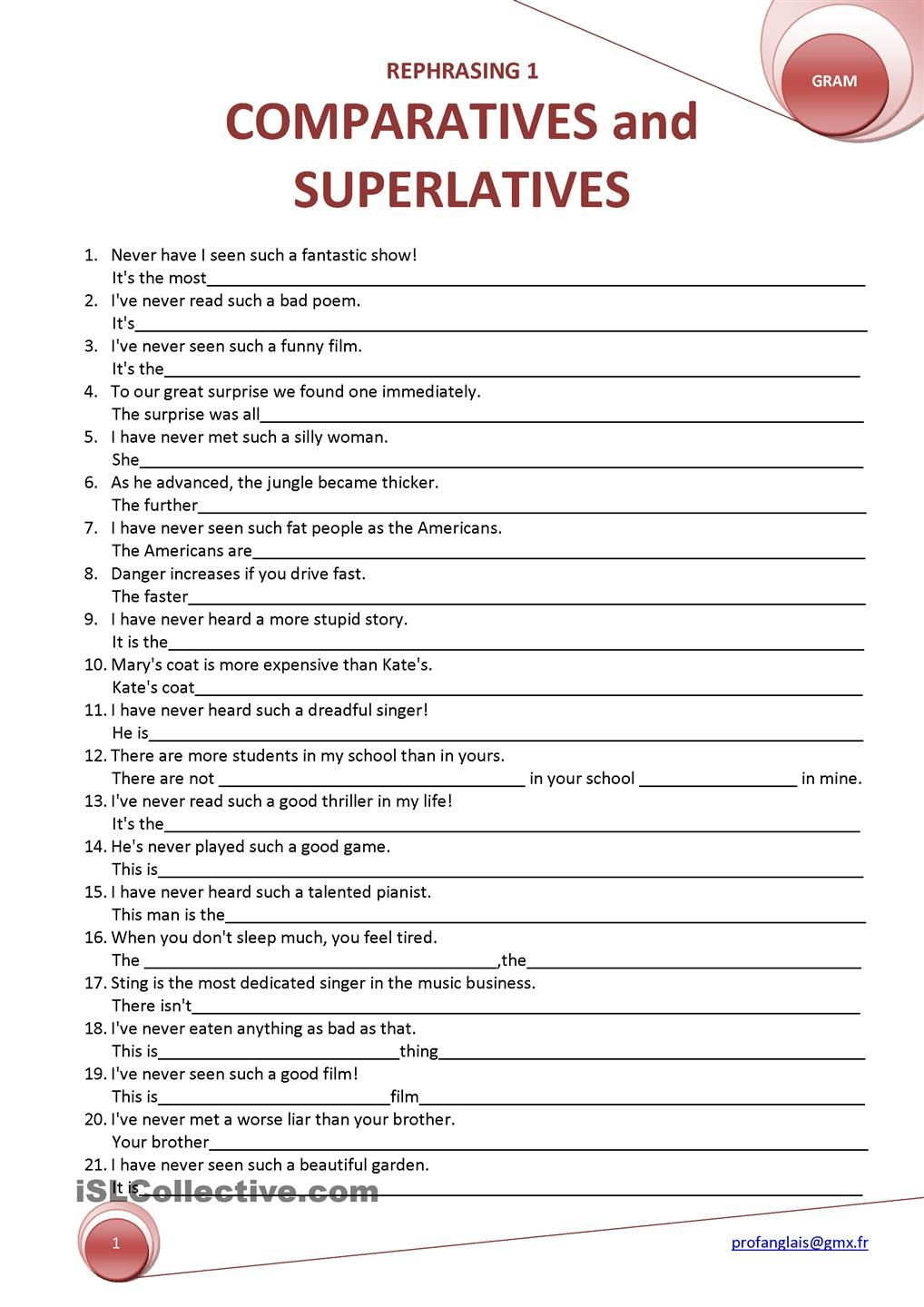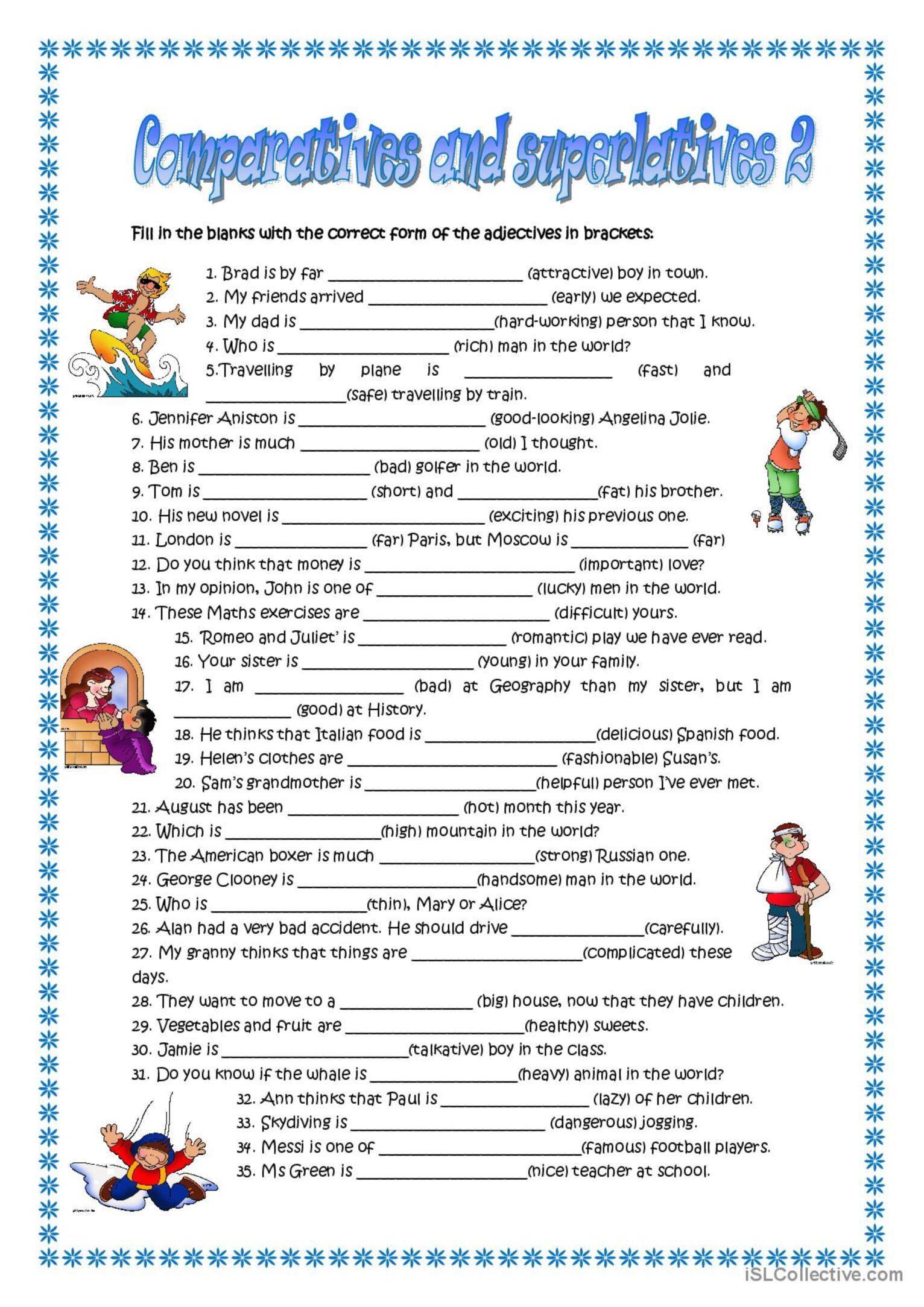Mastering Comparatives and Superlatives: Fun Worksheet Ideas

Comparatives and superlatives are fundamental aspects of English grammar, which help learners express comparisons and describe extremes effectively. These grammatical constructs allow speakers and writers to make their communication richer and more nuanced, comparing characteristics, quantities, or qualities in a dynamic way. By mastering comparatives and superlatives, learners can elevate their English language proficiency to a new level, making their expressions more precise and engaging.
Understanding Comparatives and Superlatives

Before diving into fun worksheet ideas, let's ensure we understand these concepts:
- Comparatives: Used to compare two things, people, or groups. E.g., "This book is thicker than that one."
- Superlatives: Used to describe the extreme or the highest degree of a quality or characteristic in a group. E.g., "This is the thinnest book in the series."
Forming Comparatives and Superlatives

| Type | Form | Example |
|---|---|---|
| Comparative Adjectives (Short Words) | Adjective + -er | Tall → Taller |
| Superlative Adjectives (Short Words) | The + Adjective + -est | Fast → The Fastest |
| Comparative Adjectives (Long Words) | More + Adjective | Expensive → More Expensive |
| Superlative Adjectives (Long Words) | The Most + Adjective | Comfortable → The Most Comfortable |
| Irregular Forms | Varies | Good → Better, Best; Bad → Worse, Worst |

Fun Worksheet Ideas to Master Comparatives and Superlatives

Comparative Storytelling

Ask students to write short stories where they must use at least ten different comparatives to describe characters or events. For example:
- Jack was faster than Mark in the race.
- The princess’s dress was prettier than any other dress at the ball.
After writing, students can read their stories aloud to practice pronunciation and listening skills.
📝 Note: Ensure the stories are not too long to maintain interest and focus on the grammar aspect.
Superlative Characters

Create a worksheet where students describe famous characters (real or fictional) using superlatives. Here’s how you can set it up:
- Provide a list of characters, and students have to fill in the blanks with superlatives, like “Superman is the strongest superhero.”
- Encourage students to use their imagination to come up with their characters and the most extreme characteristics.
Comparison Games

Turn grammar practice into a game:
- Comparison Relay: Students form two teams, and each team member runs to the board to write a comparative sentence about a picture they see. The team that writes the most sentences correctly in a set time wins.
- Superlative Scavenger Hunt: Give clues in superlative form for items around the classroom, like “Find the shortest pencil.” Students must find the correct item and create a sentence with a superlative adjective about it.
Word Bank Comparisons

Provide students with a word bank of adjectives, then have them:
- Choose any two or three words and create sentences comparing or describing extreme qualities.
- Work in pairs, discussing why their choices are correct, encouraging critical thinking.
These activities foster teamwork and encourage students to think outside the box.
Picture Descriptions

Use pictures to stimulate descriptions using comparatives and superlatives:
- Give each student a different picture and ask them to describe it using at least five comparative and five superlative sentences.
- After describing, students can pair up to share their pictures, compare descriptions, and discuss any discrepancies or interesting points.
📝 Note: Selecting diverse images can broaden students’ vocabulary and provide context for learning grammar in a fun way.
Key Takeaways

Through these worksheet ideas, we’ve explored various engaging and educational methods to help students master the use of comparatives and superlatives. By integrating these exercises into lessons, students can:
- Practice using grammar in context, which aids in better retention and understanding.
- Develop creativity and communication skills through storytelling and descriptions.
- Engage in competitive and fun activities that make learning enjoyable and memorable.
The importance of these grammatical constructs lies not only in their role in language structure but also in how they enable learners to express themselves with more depth and detail. Using worksheets creatively, teachers can effectively communicate these concepts, making learning both enjoyable and effective for their students.
Can comparative and superlative adjectives be used interchangeably?

+
No, comparative adjectives are used when comparing two items or groups, whereas superlative adjectives are used to compare one against a whole group or to describe the extreme degree of a characteristic. Misusing them can lead to grammatical errors and misunderstanding.
How can I remember which adjectives take “-er” and “-est” and which use “more” and “most”?

+
Generally, one-syllable adjectives and some two-syllable adjectives ending in -y, -ow, -le, or -er take the “-er” and “-est” form. Longer adjectives or those that don’t follow this rule use “more” and “most.” Memorizing common exceptions like “beautiful” and “comfortable” is also helpful.
Why are these worksheets important for language learning?

+
Worksheets that focus on comparatives and superlatives allow learners to practice these grammatical structures in context, improving their ability to communicate nuances, compare and contrast effectively, and understand when to use specific forms for clarity and precision.